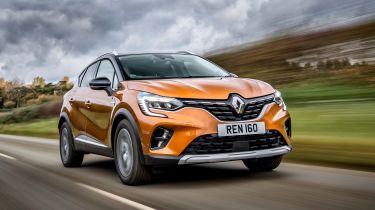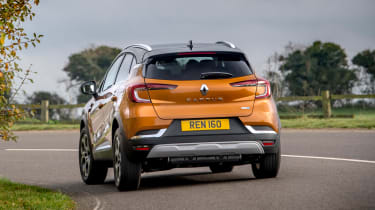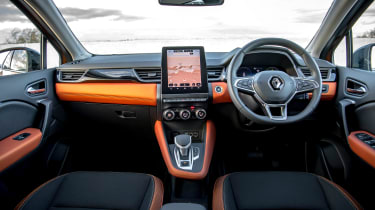New Renault Captur Plug-in hybrid 2020 review
We try the new hybrid Renault Captur E-Tech out on UK roads to see if it's the pick of the Captur lineup
Verdict
The Captur remains our favourite small SUV, but there’s a simple split when it comes to the value judgement on the Captur plug-in hybrid. If you can persuade your company to pay £5,000 more than a petrol model, you’ll be quids in when it comes to company car tax. But as a private buyer, unless you’re committed to taking your first steps towards full electrification, we’d stick with the marginally better to live with and much cheaper petrol version. Or you could go fully electric with a Peugeot e2008 for the same sort of cash.
Renault’s reinvention is going pretty well right now. It’s been winning awards aplenty, with the Clio, Captur and electric Zoe all topping their categories in the latest Auto Express New Car Awards.
Now the Zoe’s electrification tech has started filtering down through the rest of the range to create the brand’s first plug-in hybrid model: the Captur E-Tech Plug-in Hybrid.
If little luxury is what you’re after, then the Captur fits the bill perfectly. Slip inside and you’ll be greeted with a stylish interior and a really premium feel. This is the range-topping S Edition model, though, with Renault’s full gamete of safety and security initialisms present, plus an excellent array of luxury kit including LED headlights, adaptive cruise control and a hands-free keycard. It all goes some distance to justify the £30,995 starting price.
Used - available now

2023 Honda
Jazz
8,359 milesAutomaticPetrol1.5L
Cash £16,995
2023 Ford
Kuga
21,659 milesAutomaticPetrol2.5L
Cash £21,697
2023 Skoda
Kamiq
17,635 milesManualPetrol1.5L
Cash £15,197
2021 MINI
Cooper Electric
24,423 milesAutomaticElectric
Cash £12,697On board is a 1.6-litre petrol engine with two electric motors that’s fed by a 9.8kWh battery – total power of 158bhp means this is the most powerful Captur in the range. According to the official WLTP tests, you should be able to go up to 31 miles on a full charge. Maybe it was the cold weather during our tests, but a full overnight plug-in never managed to get us more than a disappointing 19 miles of charge – some way short of expectations.
Even so, the official figures are what you’ll be taxed on, and at 34g/km of CO2 that means you’ll only pay company car tax at a benefit-in-kind rate of 10% for this tax year. It means you’ll pay less than half the company car tax you would do if you bought a 1.3-litre petrol automatic car in S Edition trim, even though that car’s list price would save your company £5,000.
Numbers aside, the Captur E-Tech is a lovely thing. The silence when you pull away on electric power – as the car will always do – adds to the premium feel, while the six-speed auto slurs through the gears. And when the petrol engine does kick in, there’s a slight shiver if you’re looking for it, but otherwise you’ll barely notice.
Renault says that the E-Tech hybrid system is inspired by the energy use and recovery systems found in the company’s Formula One engines, but performance of the Captur isn’t exactly scintillating. To be fair, put your foot down and acceleration feels better than the 10.1 second 0-62mph time suggests. There’s a Sport mode that supposedly makes use of the combined engine and motors’ potential, but most owners will probably just leave the car in its MySense setting, which lets the car’s computers decide on the most efficient use of the two power sources – or both.
There’s also a Pure option if you want to run solely on electric power (if you’ve got enough charge), or you can use the E-Save function to save some of the battery’s juice for later in your journey. If you use the car’s navigation system, it’ll work out what’s best for your route and do that job for you.
Unusually for a plug-in hybrid, you can also choose a B setting via the gearbox selector, like on many fully electric cars. This ups the level of regenerative braking when you lift off the throttle, to give an option of one pedal driving just like a full EV. And just as it is in a full EV, it’s addictive and quite fun to use around town.
Our car rode on £300 optional 18” wheels, which look great (as does the £660 Desert Orange paint job with contrasting Diamond Black roof) but do little for the ride comfort. As with so many PHEVs, the extra weight that comes with having to cart a decent-sized battery pack around all the time does little for the ride quality. We wouldn’t call it harsh, but it’s not quite as plush as a standard Captur.
There’s no pay-off in the handling, either – this is a small SUV not a sports car, but a Ford Puma – albeit without the option of plug-in power – is the way to go if you enjoy your driving and need a small SUV. The Captur is more about comfort, quality and refinement.
And a decent amount of space. We had five adults in our car with no huge complaints – even the centre seat on the rear bench was mentioned as being more comfortable than most. Up front there’s plenty of storage space, too, while the portrait-orientated touchscreen is good to use with standard Apple CarPlay and Android Auto connectivity.
The boot is an okay size, hindered only by the split floor which allows for the three-pin and Type 2 charging cables that come as standard to be stored out of sight.
Not every PHEV comes with both sets of cables and even fewer come with a free home charging wallbox – courtesy of BP Pulse – which will charge the car in approximately three hours. There’s also Renault’s standard, generous five-year warranty with an extra three years’ cover for the battery.
| Model: |
Renault Captur S Edition E-TECH Plug-in Hybrid 160 Auto |
| Price: | £30,995 |
| Powertrain: |
1.6-litre four-cylinder petrol plus 9.8kWh battery |
| Power/torque: | 158bhp/n/aNm |
| Transmission: |
Six-speed automatic, front-wheel drive |
| 0-62mph: | 10.1 secs |
| Top speed: | 107mph |
| MPG: | 188.3 |
| CO2: | 34 g/km |
| On sale: | Now |










